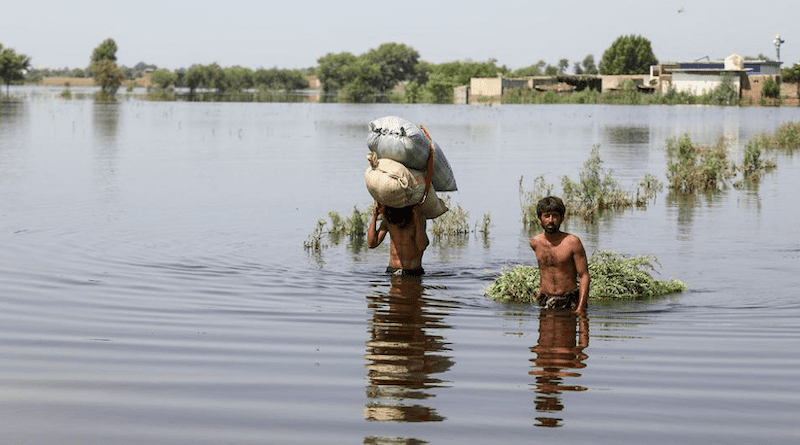Pakistan’s Economy After The Floods – OpEd
When Pakistan received tranche of US$1.2 billion from International Monetary Fund (IMF), it was anticipated that PKR would find solid ground against the US$. However, against expectations, the currency continued depreciation. While the country’s borrowing needs for the year are fully met, the outlook beyond FY23 remains uncertain.
As per the latest IMF document, Pakistan’s gross borrowing needs over the next 5 years are expected to top US$180 billion, meeting them or even rolling them over will be an uphill task. In the short term, the country’s borrowing needs may increase further as floods have washed away standing crops in Sindh and lower Punjab.
The country will need to import various food items to fulfill local demand and the import bill will be driven by food items. With exports likely to remain lackluster, the onus falls upon inward remittances and FDI to balance the gap between inflows and outflows.
However, the remittance inflow, which has picked up of late, has remained largely disappointing. The same can be said for RDA inflows which have also started to dry up over the past few months.
The need of the hour is to increase monthly remittances and RDA inflows while stamping out currency smuggling from the country.
Pakistan’s monthly current account deficit (CAD) for August 2022 nearly halved to US$0.7 billion, lowest since April 2022, despite hefty oil and food imports amid recent flood damages. Import curtailment gained support from administrative measures, reducing trade deficit to US$2.9 billion (a decline 4%MoM). Remittances also increased during the month to US$2.7 billion, cushioning trade deficit adequately. The month also saw a Balance of Payment surplus owing to US$1.2 billion received from IMF. Going forward, bilateral and multilateral loans and international aid for floods rehabilitation will likely provide external support.
Trade deficit has declined by a mere 4%MoM to US$2.9 billion, largely owing to administrative measures on restricting non-essential items and policy rate impact. However, food imports have increased to all-time high of US$1.0 billion up 34%MoM.
Petroleum imports have been recovered at US$1.9 billion, up 30%MoM) in August 2022. The month also saw trend reversal in PBS-SBP import difference, which has mostly remained short-lived historically.
Resumption of energy supplies amid normalized working days and lack of Eid holidays, led to the rebound in textile exports, up 18%MoM. This has led to overall exports growth of 23%MoM; helping trade deficit to remain under US$3.0 billion level.
Remittances recovered during August 2022, increasing to US$2.7 billion, up 8% MoM and cushioning the trade gap. Higher inflows from United States and Saudi Arabia have elevated overall base. Looking ahead, analysts expect decent growth numbers in FY23 backed by increase in Pakistani worker registration in GCC countries.
As per Board of Emigration and Overseas Employment (BEOE), around 531,000 Pakistanis have expatriated during 8MFY22 as against 288,000 and 225,000 during FY21 and FY20, respectively. Most of the expatriations have occurred towards Middle East countries which continue to enjoy better macros in a high oil price environment.
The overall Balance of Payment (BoP) turned to positive and stood at US$440 million. This is largely owing to US$1.2 billion tranche received from IMF under EFF facility. But to support overall BoP and foreign exchange reserves, Pakistan needs further support from international organizations and friendly countries, the deliberations with these lenders have already started. Analysts believe, the stronger US$ has continued to impact PKR, besides the low foreign exchange liquidity in the country; pushed PKR to near to its all-time low of PKR240/USD.
Pakistan has been severely impacted by the recent floods as it has led to massive damage to country’s physical infrastructure including damage to homes, roads, bridges etc.
As per National Disaster Management Authority (NDMA) a cumulative loss of 1.76 million houses (partially and fully damaged), 390 bridges and roads (distance of 12,718km) has already taken place till September 14, 2022.
Therefore, there is a need to explore cement sector outlook, especially after floods. A brokerage house made an attempt to estimate the impact. The manufacturers cumulatively represent 76% of the total industry size in terms of plant capacity.
The survey results show that 75% of the participants expect domestic cement dispatches to fall in the range from 0% to 10%YoY in FY23 as against 2MFY22 fall of 35%. Around 17% of the participants anticipate growth of 10% or above and 8% expect it to increase from 0% to 10%.
This likely fall in local sales is better than initial expectation of a larger fall due to floods and economic slowdown.
Cement manufacturers anticipate cement demand to pickup next year as 83% of the participants expect demand to remain in the range of 0% to more than 10% in FY24 whereas 17% of the manufacturers believe it will increase from 10% to 20% as construction activity will pick up once relief measures complete and the water starts receding.
The survey results also show that rebuilding or reconstruction activity could at least take 3 to 6 months. 42% of the participants expect it to start after 1 to 3 months whereas 42% of the participants believe it will start after 3 to 6 months. On other hand, 17% of the participants anticipate that it will start after 6-9 months.

